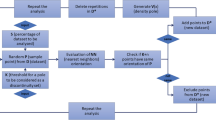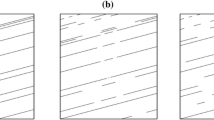Abstract
The location and orientation of rock discontinuities, which are traditionally obtained from geological surveys with obvious drawbacks (safety, rock face accessibility, etc.), may also be derived from a detailed and accurate photogrammetric or laser scanning survey. Selecting from the point cloud determined on the rock face a set of points distributed on a particular discontinuity, location, dip, and dip direction can be computed from the least-squares estimate of the plane interpolating the set of points. Likewise, the normal vector to the surface may be computed from an interpolation or approximation of the surface by appropriate functions. To become a real alternative (both in terms of productivity as well as accuracy) to a traditional survey, interactive or automated software tools are necessary, to allow the efficient selection of the point sets on the discontinuities or the interpretation of the normal vector pattern. After introducing the two best technologies available today for data acquisition and their performance, the paper presents an approach, based on the random sample consensus (RANSAC) procedure, to the segmentation of the point cloud into subsets, each made of points measured on a discontinuity plane of the rock face. For each subset, the plane’s equations coefficients are first determined by robust estimation and then refined by least-squares estimation after outlier removal. The segmentation algorithm has been implemented in RockScan, a software tool developed to facilitate the interaction with the point cloud in the identification of the discontinuities; rather than using the three-dimensional (3D) data, selection of regions of interest is performed on oriented images of the rock face. Finally, application of RockScan to four different test sites is discussed and results presented. The sites differ in size (from tens to hundreds of meters), rock surface characteristics, and the technology used to produce the point cloud (in three cases photogrammetry, in the fourth laser scanning), giving the opportunity to test the methodology in different contexts. In the first and in the fourth site an extensive traditional survey has been performed, providing reference data to validate the RockScan results.


















Similar content being viewed by others
References
Barla G, Barla M (2000) Continuum and discontinuum modelling in tunnel engineering Građevinar 52, Num 10
Barla G, Barla M (2001) Continuo e discontinuo nella modellazione numerica dello scavo di gallerie. Gallerie e grandi opere sotterranee n.61
Besl PJ, McKay ND (1992) A method for registration of 3-D shapes. IEEE Trans Pattern Anal Mach Intell 14(2), February
Birch JS (2006) Using 3DM analyst mine mapping suite for rock face characterization. In: Tonon F, Kottenstette J (eds) Laser and photogrammetric methods for rock face characterization. ARMA Golden, Colorado
Crosta G (1997) Evaluating rock mass geometry from photographic images. Rock Mech Rock Eng 30(1):35–58
Cruden DM (1977) Describing the size of discontinuities. Int J Rock Mech Min Sci Geomech Abstr 14:133–137
Davis JC (1986) Statistics and data analysis in geology. Wiley, New York, p 646
Dolan JP (2006) Rapidly acquiring and analyzing rock mechanic data using laser scanning technology workshop on laser and photogrammetric methods for rock face characterization. ARMA, Golden, Colorado
Felus YA (2006) On linear transformations of spatial data using the structured total least norm principle. Cartogr Geogr Inf Sci 33:195–205
Feng Q, Sjogren P, Stephansson O, Jing L (2001) Measuring fracture orientation at exposed rock faces by using a non-reflector total station. Eng Geol 59:133–146
Ferrero AM, Migliazza MR, Giani GP (2004) Analysis of the stability condition of tunnels: comparison between continuous and discontinuous approaches. Int J Rock Mech Geomech Abstr 41(3):483
Ferrero AM, Forlani G, Migliazza MR, Roncella R, Grasso P, Rabbi E (2007) Analysis of stability conditions of rock slopes based on laser scanner surveys. XI ISRM Congress Lisbon
Fischler M, Bolles R (1981) Random sample consensus: a paradigm for model fitting with application to image analysis and automated cartography. Commun Assoc Comp Mach 24(6):381–395
Gaich A, Schubert W, Pötsch M (2004) Reproducible rock mass description in 3D using the JointMetriX3D system. In: Schubert W (ed) Proceedings of EUROCK 2004 and 53rd geomechanics colloquium. Salzburg, Austria, pp 61–64
Gaich A, Pötsch M, Schubert W (2006) Basics, principles and applications of 3D imaging systems with conventional and high-resolution cameras. In: Tonon F, Kottenstette J (eds) Laser and photogrammetric methods for rock face characterization. ARMA Golden, Colorado
Golub GH, Van Loan CF (1989) Matrix computations, 2nd edn. The John Hopkins University Press, Baltimore
Grenon M, Lemy F, Hadjigeorgiou J (2004) Fracture modelling based on input data from line mapping and image analysis. In: Schubert W (ed) Proceedings of EUROCK 2004 and 53rd geomechanics colloquium. Salzburg, Austria, pp 445–448
Grün A (1985) Adaptive least squares correlation: a powerful image matching technique. S Afr J Photogramm Remote Sens Cartogr 14(3):175–187
Grün A, Baltsavias EP (1988) Geometrically constrained multiphoto matching. Photogramm Eng Remote Sens 54(5):663–671
Hadjigeorgiou J, Lemy F (2005) Développement d’un système d’analyse d’images pour la caractérisation des massifs rocheux. Rapport soumis à l’Institut de recherche Robert-Sauvé en santé et sécurité du travail (IRSST). (Rapport R-414), pp 46
Hadjigeorgiou J, Lemy F, Côté P, Maldague X (2003) An evaluation of image analysis algorithms for constructing discontinuity trace maps. Rock Mech Rock Eng 36(2):163–179
Hagan TO (1980) A case of terrestrial photogrammetry in deep-mine rock structure studies. Int J Rock Mech Min Sci 15:191–198
Harrison JP (1993) Improved analysis of rock mass geometry using mathematical and photogrammetric methods. Ph.D. thesis, Imperial College, London, UK
Héliot D (1988a) Conception et Réalisation d’un Outil Intégré de Modélisation des massifs Rocheux Fracturés en Blocs. Ph.D. Thèse, Institut National Polytechnique de Lorraine
Héliot D (1988b) Generating a blocky rock mass. Int J Rock Mech Sci Geomech Abstr 25(3):127–138
ISRM Commission for Standardization of Laboratory and Field Tests (1978) Suggested methods for the quantitative descriptions of discontinuities in rock masses. Int J Rock Mech Min Sci 15(6):319–368
Itasca Consulting Group (1998) Minnepolis, MN, 3DEC, ver. 2
Jing L (2003) A review of techniques, advances and outstanding issue in numerical modelling for rock mechanics and rock engineering. Int J Rock Mech Min Sci, 40 (journal review article)
Jing L, Hudson JA (2002) Numerical methods in rock mechanics. Int J Rock Mech Min Sci 39:409–427 (civil zone review paper)
Kemeny J, Post R (2003) Estimating three-dimensional rock discontinuity orientation from digital images of fracture traces. Comput Geosci 29(2003):65–77
Kemeny J, Monte Handy J, Thiam S (2003) The use of digital imaging and laser scanning technologies in rock engineering. In: International symposium on the fusion technology of geosystem engineering, Rock engineering and geophysical exploration, Seoul, Korea, 18–19 November
Kemeny J, Turner K, Norton B (2006) LIDAR for rock mass characterization: hardware, software, accuracy and best-practices. In: Tonon F, Kottenstette J (eds) Laser and photogrammetric methods for rock face characterization. ARMA Golden, Colorado
Kraus K (1993) Photogrammetry, vol 1, 4th edn. In: Dummler F (ed), Bonn. ISBN:3-427-78684-6
Kulatilake PHS, Wathugala DN, Stephansson O (1993) Joint network modelling with a validation exercise in Stripa Mine, Sweden. Int J Rock Mech Min Sci 30:503–526
LAEGO-INERIS (1999) Resoblok bg bd bh v4.01 BSA Rapport interne, Ecole des Mines de Nancy
Lemy F, Hadjigeorgiou J (2003) Discontinuity trace map construction using photographs of rock exposures. Int J Rock Mech Min Sci 40:903–917
Lichti DD, Jamtsho M (2006) Angular resolution of terrestrial laser scanners. Photogramm Rec 21(114):141–160
Priest SD (1993) Discontinuity analysis for rock engineering. Chapman & Hall (eds), London, p 472
Priest SD, Hudson J (1976) Discontinuity spacings in rock. Int J Rock Mech Min Sci Geomech Abstr 13:135–148
Priest SD, Hudson J (1981) Estimation of discontinuity spacing and trace length using scanline survey. Int J Rock Mech Min Sci Geomech Abstr 18:183–197
Reid TR, Harrison JP (2000) A semi-automated methodology for discontinuity trace detection in digital images of rock mass exposures. Int J Rock Mech Min Sci 37:1073–1089
Roncella R, Forlani G (2005) Extraction of planar patches from point clouds to retrieve dip and dip direction of rock discontinuities. Proceedings of laser scanning 2005, Enschede, The Netherlands. Int Arch Photogramm Remote Sens 36(3W19):162–167
Roncella R, Forlani G, Remondino F (2005) Photogrammetry for geological applications: automatic retrieval of discontinuity orientation in rock slopes. In: Videometrics IX, electronic imaging, IS&T/SPIE 17th annual symposium, pp 17–27
Slob S, Hack HRGK, van Knapen B, Turner K, Kemeny J (2005) A method for automated discontinuity analysis of rock slopes with 3D laser scanning. Transp Res Rec 1913(1):187–208
Terzaghi RD (1965) Sources of error in joint surveys. Géotechnique 15:287–304
Torr PHS, Murray DW (1997) The development and comparison of robust methods for estimating the fundamental matrix. In: Int J Comput Vis, Kluwer Academic Publishers, Boston, pp 1–33
Tsoutrelis CE, Exadactylos GE, Kapenis AP (1990) Study of the rock mass discontinuity system using photoanalysis. In: Rossmanith HP (ed) Mechanics of jointed and faulted rock. Balkema, Rotterdam, pp 103–112
Vallet J, Skaloud J, Koelbl O, Merminod B (2000) Development of a helicopter-based integrated system for avalanche and hazard management. Int Arch Photogramm Remote Sens 33/B2:565–572 (Amsterdam)
Voyat IH, Roncella R, Forlani G, Ferrero AM (2006) Advanced techniques for geo structural surveys in modelling fractured rock masses: application to two Alpine sites. In: Tonon F, Kottenstette J (eds) Laser and photogrammetric methods for rock face characterization. ARMA Golden, Colorado
Zhang L, Einstein HH (1998) Estimating the mean trace length of rock discontinuities. Rock Mech Rock Eng 31(4):217–235
Zhang L, Einstein HH (2000) Estimating the intensity of rock discontinuities. Int J Rock Mech Min Sci 37:819–837
Acknowledgments
This work has been supported by Valle d’Aosta Region within the research program Interreg III A “Rock Slide Detect” and by the Interreg III B Alpine Space project “ClimChAlp”. The data on Mount Granier were kindly provided by the Université Joseph Fourrier, Grenoble.
Author information
Authors and Affiliations
Corresponding author
Rights and permissions
About this article
Cite this article
Ferrero, A.M., Forlani, G., Roncella, R. et al. Advanced Geostructural Survey Methods Applied to Rock Mass Characterization. Rock Mech Rock Eng 42, 631–665 (2009). https://doi.org/10.1007/s00603-008-0010-4
Received:
Accepted:
Published:
Issue Date:
DOI: https://doi.org/10.1007/s00603-008-0010-4




